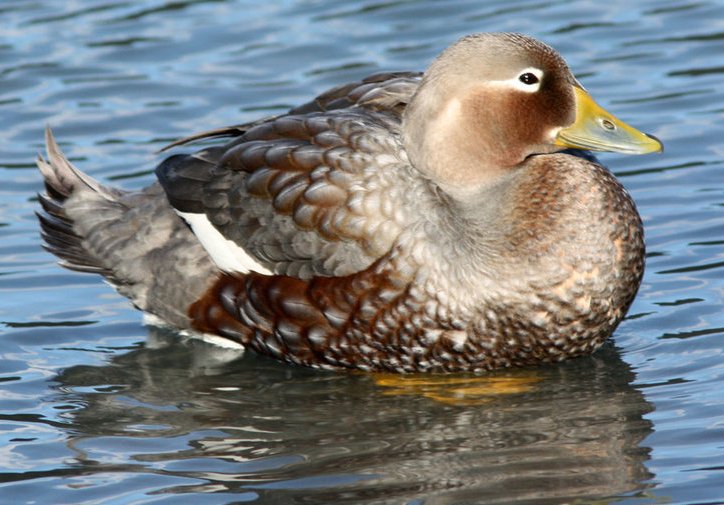
Flying steamerduck(Tachyeres patachonicus)
Phylum —chordata
Class — aves
Order — anseriformes
Family — anatidae
Genus –tachyeres
Appearance
Though they are the smallest of the four Tachyeres species, flying steamer ducks share similar plumage traits with other steamer ducks including brown head and neck feathers with white stripes stretching from their eyes to the napes of their necks, and brown-gray gradient body feathers. Their underbellies are mostly white, and their feet are orange. Female flying steamer ducks have smaller bills relative to males that are orange with black tips, while males have darker gray bills with slight yellow accents.
Flying steamer ducks undergo three molts per annual cycle, and these molts vary widely with geographic location. The wear and degradation on the primary and secondary feathers of flying steamer ducks varies depending on the location and flight behavior of the individuals.
Length – 620-650 mm.
Habitat
Flying steamer ducks inhabit aquatic areas at the southern tip of South America, specifically Chile and Argentina, Tierra del Fuego, and the Falkland Islands.
Behavior
More often than not, it is found in pairs, but also in groups, sometimes of up to 40 or 50 individuals.
Roosting grounds are rocky coasts or gravel and sandy beaches. Upon danger it quickly gets into the water.If it must flee it prefers to swim or patter along the surface.
Diet
Flying steamer ducks have almost exclusively been observed to forage in pairs, preferring to dive either around deep-water kelp beds or around shallow water zones. Flying steamer ducks share dietary preferences with other steamer duck species and have been reported to feed on mollusks and crustaceans as well as other marine invertebrates.
Reproduction
Little is known about the breeding rituals of flying steamer ducks. They are thought to be mostly monogamous and spend much of their time together in pairs.
They engage in highly ritualized mating, in which the male and female begin by dipping their bills into the water at increasingly fast paces before the female submerges almost completely into the water and is mounted by the male, after which the female and male raise their bills high into the air in a hostile fashion and grunt audibly.
The flying steamer duck nests behind the shoreline on marine coasts or freshwater lakes and ponds; sometimes the nest is built quite far from the water on the ground, concealed among grasses and brambles; the female lays and incubates up to nine creamy ivory white eggs while the male helps with caring of chicks.
Incaptivity
Longevity in captivity – 20 years.
In captivity, you can feed ducks with hard varieties of barley and buckwheat, fresh fish, small crustaceans, and bloodworms. The feed should be crushed, but not too finely.
Birdsshould eat together with their food small pebbles and clean river sand. It is also important that ducks have round-the-clock access to clean drinking water. Ducklings eat the same things as chickens — grass, boiled egg, vitamin supplements.
The owner should take care of regular cleaning in the duckling house. This will help to avoid the spread of various diseases. Since wild ducks have a strong immune system, their vaccination is carried out only on farms with low disease rates.
It is important for the bird to have an opportunity to walk freely on the territory of the poultry house — for wild ducks, walking and the availability of natural or artificial reservoirs are mandatory. The paddock should be equipped with a canopy that will help protect the birds from rain and sun.
It is necessary to take care of protecting the herd from severe frosts and provide for the possibility of warming the room. To avoid various infections,the poultry house should be ventilated daily. The room should be clean and dry. The poultry house itself should be quite spacious — the ideal density of heads is no more than three per square meter. In the warm season, waterfowl feel comfortable in the fresh air, where they can stay all day long.
In cold weather, the owners should organize lighting (daylight hours to preserve egg production should last at least 14 hours) and insulate the floors with a thick layer of straw bedding.
 Russian
Russian
 English
English
























